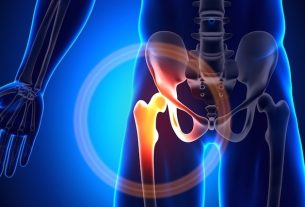Osteoarthritis is the degeneration of cartilage in a joint in the body, such as the knee, spine, shoulder or hip, which leads to inflammation of the area due to the contact of one bone with another, resulting in symptoms such as swelling, chronic pain, stiffness and difficulty performing movements.
Osteoarthritis, also known as osteoarthritis, is more common in older people due to natural wear and tear on joints or as a result of repetitive movements, trauma, or being overweight, for example.
The treatment of osteoarthritis must be carried out by an orthopedist or rheumatologist who may recommend the use of medicines to alleviate symptoms, physiotherapy and, in the most serious cases, surgery.

Osteoarthritis symptoms
The main symptoms of osteoarthritis are:
- Chronic pain in the affected joint;
- Difficulty performing movements;
- Swelling and local redness;
- Increased sensitivity in the joint;
- Loss of flexibility;
- Joint stiffness, especially after waking up;
- Feeling of numbness or tingling in the legs or arms;
- Presence of clicking noises when moving the joint;
- Feeling of sand when moving the joint;
- More limited movements in the affected limb;
- Weaker and more atrophied muscles, close to the affected joint.
Furthermore, as the disease progresses, deformities may also appear in the affected joint region, which can make symptoms more intense.
Therefore, in the presence of symptoms of osteoarthritis, it is important that the orthopedist is consulted so that the diagnosis can be made, the possible cause identified and the most appropriate treatment initiated.
How the diagnosis is made
The diagnosis of osteoarthritis is made by an orthopedist or rheumatologist through the evaluation of symptoms, personal and family health history, in addition to a physical examination, in which movements are performed in the affected joint with the aim of checking whether there is any limitation of movement or whether there is pain during its execution.
In addition, the doctor usually recommends imaging tests, such as X-ray or MRI, to check the degree of wear on the joint and, thus, confirm the diagnosis, the type of osteoarthritis, and indicate the best treatment.
Types of osteoarthritis
Osteoarthritis can be classified into several types according to the affected joint, the main ones being:
1. Knee osteoarthritis
Knee osteoarthritis affects the knee cartilage, which can cause difficulty walking, bending down, climbing stairs and stretching the leg, for example. It is common for osteoarthritis to be noted in both knees, however the degree of change may vary between them. Find out more about knee osteoarthritis.
2. Hip osteoarthritis
In this type of osteoarthritis, the joints that support the body’s weight, such as the hips, are compromised, causing pain and difficulty in walking. See more about hip osteoarthritis.
3. Osteoarthritis of the spine
In osteoarthritis of the spine, there is wear and tear on the cartilage of the vertebrae, which can affect different regions of the spine, the neck region, known as cervical arthrosis, or at the end of the lumbar spine, causing pain in the neck and back and difficulty moving. Check out other symptoms of osteoarthritis in the spine.
4. Osteoarthritis of the hands
This type of osteoarthritis affects the joints of the hands, the joints of the fingers and especially the thumb are affected, causing symptoms of pain, swelling, deformities in the fingers, difficulty in picking up small objects such as pens or pencils and lack of strength. Find out more about osteoarthritis in the hands.
5. Shoulder osteoarthritis
Shoulder osteoarthritis affects the cartilage of the shoulder joint, causing symptoms of pain in the shoulder that radiates to the neck and difficulty moving the arm. Learn more about shoulder osteoarthritis.
Possible causes
The exact cause of osteoarthritis is not fully understood, however, it arises due to wear and tear on the joint, which results in the contact of one bone with another and inflammation, since the cartilage’s function is to protect the joint, preventing friction. between the bones.
Some factors may contribute to increasing the risk of developing osteoarthritis, such as:
- Natural wear and tear on the joint, which occurs due to age;
- Family history of osteoarthritis;
- Overweight or obesity;
- Metabolic syndrome;
- Congenital joint deformities;
- Muscle weakness;
- Joint misalignment;
- Injuries such as fractures, sprains or blows that affect the joint;
- Menopause, in women;
- Smoking habit;
- Vitamin D deficiency;
- Low bone density or osteoporosis;
- Systemic lupus erythematosus;
- Rheumatoid arthritis;
- Hemochromatosis;
- Drop;
- Diabetes mellitus;
- Bone dysplasia;
- Repetitive efforts, such as repeatedly squatting or kneeling while lifting heavy objects;
- Practice of sports that overload the joints or that require constant twisting movements, such as football, baseball or American football;
- Work that overloads some joints, such as construction workers, seamstresses, painters or people who carry out domestic work.
When these factors are present, an inflammatory process occurs in the area, which also affects the bones, muscles and ligaments in the region, causing progressive degeneration and destruction of the joint.
How the treatment is carried out
The treatment of osteoarthritis must be carried out under the guidance of a rheumatologist or orthopedist, with the aim of relieving symptoms and preventing the disease from progressing.
The main treatments for osteoarthritis that may be recommended by your doctor are:
1. Use of medications
Medications for the treatment of osteoarthritis that may be recommended by your doctor include analgesics, such as paracetamol, or anti-inflammatories in the form of tablets, such as ibuprofen or naproxen, or ointments, such as diclofenac, diethylammonium or capsaicin, as they help control pain and joint inflammation.
In addition, the doctor may also recommend the use of duloxetine, which is an antidepressant that helps relieve chronic pain caused by osteoarthritis. See more medication options for osteoarthritis.
2. Physiotherapy
Physiotherapy for osteoarthritis may be recommended by your doctor to help strengthen the muscles around the affected joint, increase flexibility and reduce pain, improving joint movement and reducing stiffness.
This treatment must be guided by a physiotherapist who will indicate the most appropriate exercises on an individual basis, according to the stage and type of osteoarthritis.
During physiotherapy sessions, electrostimulators and ultrasound devices may be used to stimulate the joint, reduce inflammation, facilitate healing and control pain. When there is poor posture, the physiotherapist can perform global postural re-education (RPG).
In addition, the physiotherapist can also give exercises to be done at home to complement the physiotherapeutic treatment, in addition to recommending applying ice or heat to the region to alleviate the symptoms of osteoarthritis. Find out how physiotherapy for osteoarthritis is performed.
3. Weight loss diet
In cases where osteoarthritis, especially of the knee or hip, is related to excess weight or obesity, in which the person has a BMI greater than 25, the doctor may recommend consultation with a nutritionist in order to start a diet to weight loss, individually.
Furthermore, it is important to eat an anti-inflammatory diet, which helps reduce the production of substances in the body that stimulate inflammation, such as prostaglandins and cytokines.
Therefore, it is recommended to increase the consumption of foods rich in vitamins, omega-3, polyphenols, carotenoids or flavonoids, such as tuna, sardines and salmon, strawberries, oranges, avocados, chestnuts, walnuts or broccoli, for example. Check out the complete list of anti-inflammatory foods.
4. Joint infiltration
Infiltration into the affected joints can be done by the doctor with injections of corticosteroid medications or hyaluronic acid, for example.
This type of treatment is generally indicated in cases of moderate to severe pain that does not improve with the use of oral medications.
Corticosteroid injections into the joints help to improve pain immediately and can last for up to 12 weeks.
The injection of hyaluronic acid, which is a substance similar to a component normally found in joints that acts as a shock absorber, helps to lubricate painful joints in the hands or fingers and, therefore, can help alleviate pain.
5. Surgery
Surgery is indicated in cases where the use of medication and physiotherapy have not been effective in relieving the symptoms of osteoarthritis, and the pain persists, even after months of conventional treatment.
The operation can be performed by scraping the joint or removing the affected joint and placing a prosthesis in its place. It is generally necessary to undergo physiotherapy sessions to speed up recovery. Find out how it is done and how long recovery takes. See other treatment options for osteoarthritis.
How to prevent osteoarthritis
One of the main forms of treatment is the prevention of osteoarthritis, and to achieve this there are some precautions that must be followed, which include:
- Avoid excess weight;
- Maintain good body posture;
- Avoid lifting weights, especially in the shoulder region;
- Avoid performing repetitive exercises;
- Avoid carrying out forced labor.
Osteoarthritis is a chronic degenerative disease and there is therefore no good prognosis for the disease, with treatments serving to alleviate pain and inflammation, slow the progress of the disease, improve movement and quality of life.

Sign up for our newsletter and stay up to date with exclusive news
that can transform your routine!
Warning: Undefined array key "title" in /home/storelat/public_html/wp-content/plugins/link-whisper-premium/templates/frontend/related-posts.php on line 12
Warning: Undefined array key "title_tag" in /home/storelat/public_html/wp-content/plugins/link-whisper-premium/templates/frontend/related-posts.php on line 13



